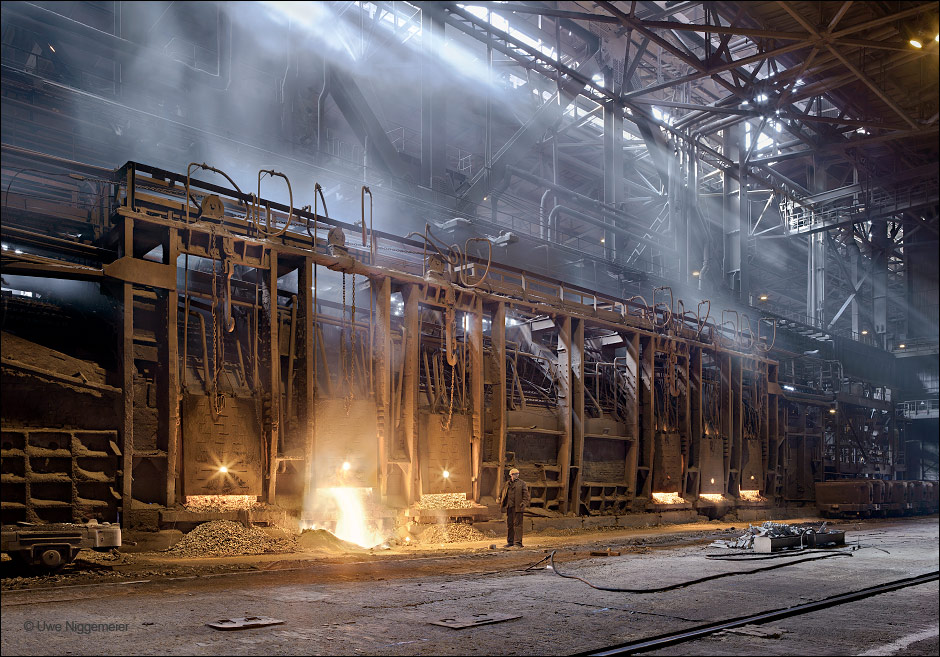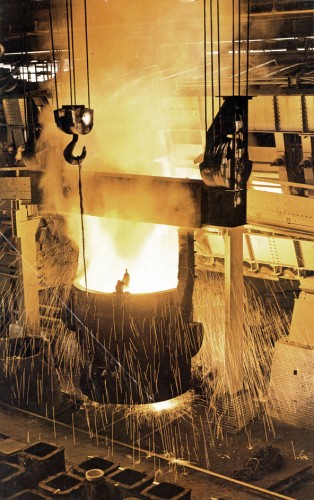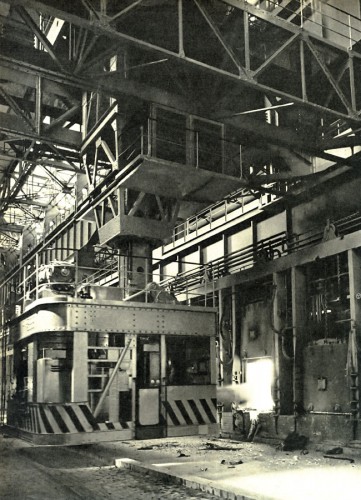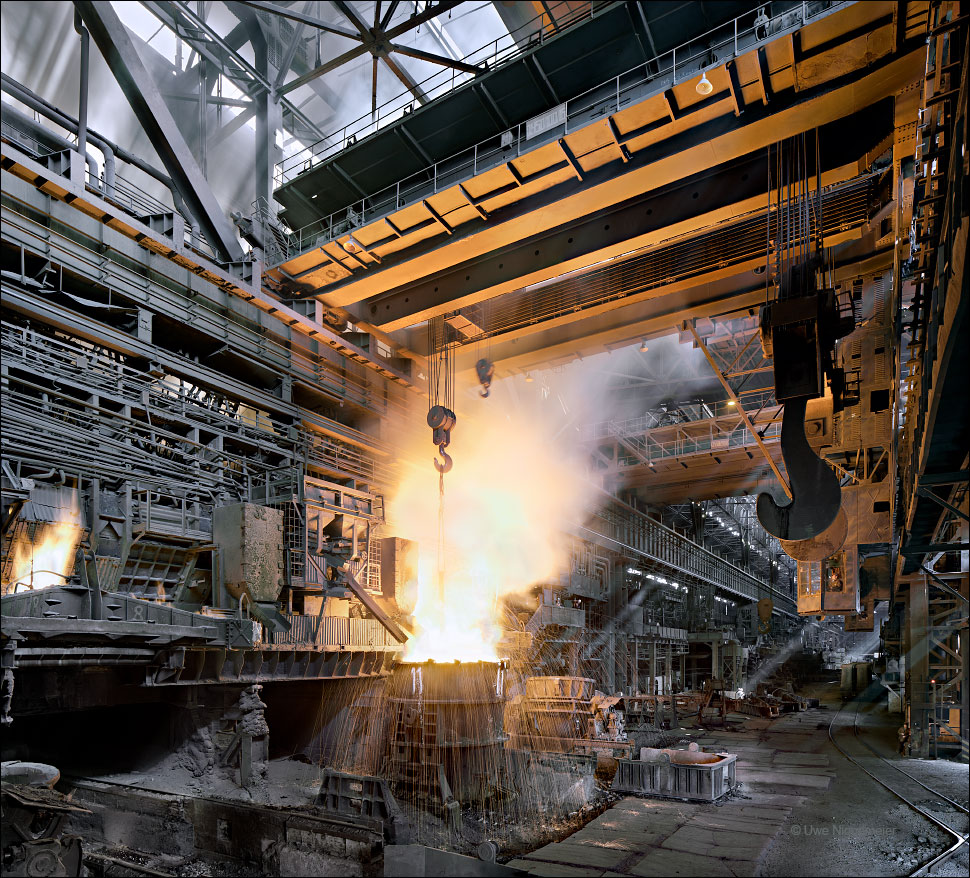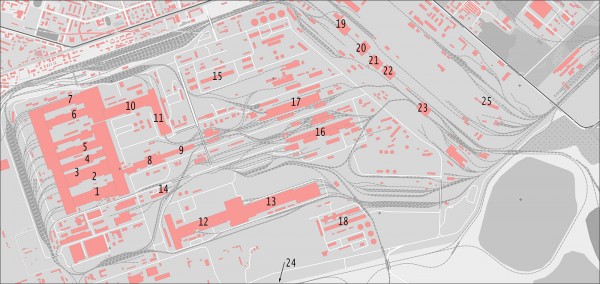AM Krivoy Rog, Ukraine announced to close it’s last open hearth furnace as soon as the modernization of BOF vessel No. 5 is finished. This will probably happen in late 2014.
The 700 ton tandem open hearth furnace No. 6 is the last of it’s kind at ArcelorMittal, the worlds’s largest steel producer.
Further images.
Tag Archives: Open Hearth
Last Open Hearth Built In West Germany ?
In between 1954 and 1962 the Hoesch company in Dortmund, Germany built it’s third open hearth melt shop (SM-Stahlwerk III).
Two 180 ton furnaces were installed by 1956, two DEMAG 210 ton furnaces were added in 1961 and 1962. These might have been the last to be commissioned in West Germany.
Monthly output was less than 100000 tons, not enough to compete with the new BOF shop in Dortmund Hörde built in 1963 producing more than 300000 t/m.
The open hearth shop 3 was closed in 1982.
Some images of it’s remains: Stahlseite.
The Last Open Hearth In The U.S.

© Chris Dunker (Dunker Imaging)
was closed down in December 1991 at Geneva Steel in Utah. The end of an era for a nation that, in 1970, still produced nearly 40% of it’s raw steel out of open hearth furnaces.
The Geneva OH-shop contained ten 340 ton furnaces first tapped in 1944 and upgraded in between 1957 and 1964.
They were replaced by two 225 ton Q-BOF vessels originally installed at Republic Steel’s (later LTV Steel) South Chicago works in 1991.
For an unknown reason the Geneva Steel company, the successor of U.S. Steel, left the open hearth shop standing until they finally went bancrupt in 2002 and the mill was dismantled in 2004.
Large portions of the mill (caster, plate and strip rolling mill) were sold to Chinese steel maker Qindago Steel.
In 2004 Chris Dunker was allowed to document the demolition of the mill with his camera.
Part of the work can be seen in his book: “Dismantling Geneva Steel”.
700 Ton Open Hearth Furnace
The steel mill in Kryvyi Rih (Russ. Krivoy Rog) was founded in 1931 on the rich iron or deposits of the Ukrainian Kryvbas basin.
In 1934 the mill was ready to produce hot metal out of one blast furnace. By 1939 three blast furnaces a coke plant and a Bessemer shop were in operation. In the second world war the Kryvyi Rih Metallurgical Works were dismantled by the Soviets and the remains destroyed by the German army.
In 1949 blast furnace No.1 was blown on. By 1960 four rolling mills and a 600 ton open hearth furnace were installed.
Blast furnace No.7 was built in 1962, No. 8 and No. 9 (one of the largest worldwide) followed in 1970 and 1974.
In 1996 the Kryvyi Rih State Mining and Metallurgical Combine (Krivorizhstal) brought together the metallurgical and the mining activities in the Kryvbas basin.
In 2004 the mill was privatized for the first time to an Ukrainian syndicate.
This was canceled one year later and the second privatisation found the Mittal Steel company as a new owner.
Since 2007 Krivorizhstal is part of the worlds largest steel company ArcelorMittal.
Today ArcelorMittal Kryvyi Rih employs 35000 people main products are billets, bars, rod and wire.
Further viewing.
1: Light-section mill 250-2
2: Rod mill 150-1
3: Light-section mill 250-1
4: Light-section mill 250-3
5: Light-section mill 250-4
6: Light-section mill 250-5
7: Rod mill 250-3
8: Blooming mill No.1
9: Soaking pits
10: Blooming mill No.2
11: Soaking Pits
12. Light-section mill 250-6
13: Wire mill
14: Forge shop
15: Oxygen plant
16: BOF shop (6×160 ton)
17: Open hearth shop (1×550 ton, 1×700 ton)
18: Power station
19: Blast furnace No.8
20: Blast furnace No.7
21: Blast furnace No.6
22: Blast furnace No.5
23: Blast furnace No.1
24: Blast furnace No.9
25: Coke plant (6 batteries)
Donetskstal, the last days of Siemens-Martin
The video shows the Donetskstal open hearth shop a few days before it was closed down for good in April 2012.
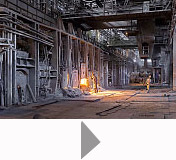 Donetskstal was founded in 1870 by the Welsh engineer John Hughes.
Donetskstal was founded in 1870 by the Welsh engineer John Hughes.
Most installations were imported from England and iron production in one blast furnace started in 1872.
By 1910 the plant had 6 blast furnaces, 9 open-hearth furnaces, 2 Bessemer converters, blooming, rail, structural, sheet, and some section rolling mills and a a coking plant.
From 1928 to 1961 the mill was named Stalino Iron Works.
In 1953 the 2300mm plate mill was installed which is still in use today.
Blast furnace 1 was built in 1956,NO 2 one year later. Both where completly modernised in 2002 and 2006.
One of the first continuous casters worlwide was built in 1960.
Two blast furnaces and several pig iron casters are actually producing.
More inside views.

